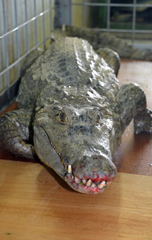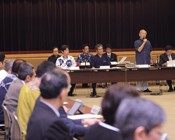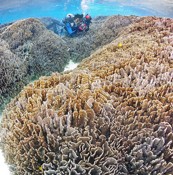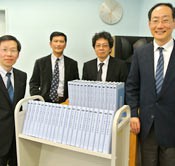Top News

April 13, 2014 Ryukyu Shimpo
Around 8:43 a.m. on April 12, the police received a phone call that a reared crocodile had escaped from a restaurant in Mihama district of Chatan. The restaurant was temporarily closed for renovations. At 9:55 a.m., the police officers found the crocodile at a site located at the back of the restaurant. After about an hour, they captured the reptile with the help of staff from the Okinawa Zoo & Museum. According to the Okinawa City Police Office, the crocodile did not hurt the officers and the local people even though it resisted a little. The zoo temporarily took the crocodile into its care.
According to a spokesperson of the zoo, the crocodile is a spectacled caiman which is about 150 centimeters long and weighed about 25 kilograms.
An owner of the restaurant named “Crocodile”, which is located within Mihama American Village in Chatan, has been raising the crocodile as a pet for 15 years. Around 7:00 a.m. on April 12, one of the restaurant staff noticed the crocodile escaping from a pond in the restaurant, and reported to the police office. After that, several dozen police officers surrounded the crocodile and captured it by using special tools while local residents were watching. It is unclear how the crocodile escaped.
According to the restaurant owner Riki Matsuyama, he has been raising the crocodile in the restaurant pond since the zoo handed it over to him.
Matsuyama has temporarily closed the restaurant for renovation in order to obtain permission from the local government to raise dangerous animals within the facility. Matsuyama said the crocodile never bites or hurts people. He went on to say, “I am glad the crocodile was safely found and nobody was injured. I am sorry to have disturbed neighbors.”
(English translation by T&CT)
Go to Japanese

April 10, 2014 Naoki Isa of Ryukyu Shimpo
Thirty-three-year-old Akiko Yamakawa from Nago City has been training to become a top makeup artist in the United States. Although she could not speak English in the beginning, she set her mind on success and moved to the United States at the age of 31. At the world’s biggest makeup fair International Makeup Artist Trade Show (IMATS) in January, she won second prize.
Yamakawa used to work in Okinawa as a hair and makeup artist for TV programs. In 2010, there was a major turning point in her career when she saw a U.S.-based hair artist Yuko Tokunaga from Hyogo prefecture on TV. Yamakawa was so impressed by the veteran artist that she made a special trip to visit her. Tokunaga said, “The United States is a meritocratic society, always challenging.” Yamakawa decided to follow in her footsteps and move to a competitive world. She went to the United States in 2012.

A second prize winning piece at IMATS by Akiko Yamakawa (Photograph provided by Akiko Yamakawa).
In the daytime, she receives practical training at a school and salon Tokunaga runs, and at night she works on pieces for contests.
Throughout the year, the IMATS is held at six locations around the world. Yamakawa entered a contest in Los Angeles. Her Japanese culture and geisha-themed piece won second prize. At an international nail contest NAILPRO Sacramento held last September, she won first prize in the Hand Painted Nail Art Novice Section. She is already scheduled to enter other U.S. competitions.
Her determination to succeed in comeptitions that support her future in the US is the driving force for her success. Yamakawa said, “I would like to continue to challenge myself in this country where many people gather from all over the world.”
(English translation by T&CT and Megumi Chibana)
Go to Japanese
April 10, 2014 Masatoshi Inafuku of Ryukyu Shimpo
In this fiscal year, the Okinawa Prefectural Government (OPG) will carry out a project to interview and collect the stories of Okinawan Americans who worked for the U.S. military during the Battle of Okinawa.
It will be the first time the government has officially interviewed these Okinawan Americans. Researching in Hawaii, the government plans to interview a maximum of 15 people.
It will screen recorded footage of the interviews at the Okinawa Prefectural Peace Memorial Museum in fiscal 2015.
The government will interview Okinawan Americans who served in the US Military Intelligence Service (MIS) during the Battle of Okinawa. It also plans to interview those who declined to pledge loyalty to the United States, and were incarcerated at the Tule Lake Segregation Center.
Okinawan Americans who returned to Okinawa at the time of the Pacific War and ended up fighting for the Japanese Imperial Army will also be interviewed.
After carrying out a preliminary survey in May, the government will interview the subjects and collect their stories around August.
The Okinawan Americans who served in the MIS during the Battle of Okinawa mainly worked on translating Japanese Imperial Army documents and interviewing Japanese prisoners. They also contributed to saving local people’s lives by using Okinawan dialects to call out to those hiding in caves. Although the government has information on local people who came out of hiding and surrendered to US soldiers, it does not have official records of those who called for the local people to do so.
The Japanese Americans who were put in concentration camps were given an ultimatum to fight against Japan when ordered and pledge loyalty to the United States.
But they could not bring themselves to agree to this and were discriminated in the United States, where they were called “no-no boys”.
The Okinawa Prefectural Government chose to pursue the story-gathering project after successfully interviewing Okinawan Americans about the Battle of Okinawa for a special event held at the museum last year.
The project will cost about 15 million yen and will be subsidised by the government.
The government plans to screen recorded footage of the interview, create DVDs and hire them out.
(English translation by T&CT)
Go to Japanese

April 11, 2014 Ryukyu Shimpo
A conference aimed at reclaiming Okinawa’s status as the home of Japan’s longest living people was held on April 10. Seventy-one organizations, including the Okinawa Prefectural Government and economic and medical organizations took part in it. The conference has kicked off with the first meeting at the prefectural government office building.
Life expectancy statistics published by prefectural and city governments last February, showed Okinawa had dropped off first place in female division. Okinawa could soon lose the title of the prefecture with the longest-living people. The conference aims to appeal to Okinawan people to reclaim the title.
The conference sets out a plan to return Okinawa to the top ranking in life expectancy by 2040. For that purpose, it announced policies to increase people’s life expectancy by helping them live more healthily.
The conference will promote awareness of healthy living to the Okinawan population, seeking cooperation from Okinawan industries that affect people’s diet, work and lifestyle.
Besides encouraging people to be conscious about healthy living, it will certify as model projects local governments and business efforts to promote longevity. The conference plans to award and support these organizations.
The Okinawa Prefectural government stressed that Okinawan people in their working years, from 20-60 plus, have poorer health than the national averages. If the current trend continues, Okinawa will see a further decrease in people’s health.
To improve people’s health, the conference will work on identifying trends and dealing with common diseases in different workplaces and regions. It aims to decrease the death rate of people aged 20 to 64 by 10 percent by 2020.
To improve lifestyle habits, conference organisers plan to set up provision for general physical checkups and medical checks for people with cancer. They also intend to work on decreasing obesity rates and alcoholism.
Okinawa Governor Hirokazu Nakaima said, “I want people to discuss the issue actively and make the conference matter.”
(English translation by T&CT)
Go to Japanese
April 14, 2014 Ryukyu Shimpo
The Okinawa Defense Bureau of the Ministry of Defense has asked the Nago City Office if it can use the Henoko fishing port as a storage space for reclamation materials as it pushes on with the plan to build an alternative facility for U.S. Marine Corps Air Station Futenma.
The defense bureau has also sought Nago Mayor Susumu Inamine’s opinion on crushing the reef in order to carry out undersea drilling investigation. This detail was uncovered in an interview with a defense bureau official on April 14. The defense bureau made the application on April 11 and seeks a response from the municipal office by May 12 next year.
After Okinawa Governor Hirokazu Nakaima’s approval of the landfill application at the end of last year, the government has been accelerating plans to relocate the Futenma base to Henoko. These proposals from the defense bureau are a part of the process to start construction of the alternative base as soon as possible.
On April 14, Mayor Inamine criticized the government for its assertive approach. He said, “Of course we should be notified in advance, but there is still no adjustment to our stance.” Mayor Inamine, who was re-elected on a policy of preventing the relocation plan by exercising his authority as the mayor, says he will not accept any application or engage in any discussion based on the premise of carrying out the landfill project.
Nonetheless, the defense bureau has made the following proposals to appeal to the mayor; that it will carry out environmental research in the fishing port area and around the Henoko Dam near the planned relocation site; that it will consult to switch the waterways of the river near the site, and that it will install a belt conveyor for sediment transport.
The defense bureau has queried the city education board about the presence of buried cultural property in the construction area and Camp Schwab. They have made the proposals without a prior consultation because they speculated that the municipal office would not accept the proposals by the central government.
With regard to inquiry about the cultural property, on which the mayor is unable to exert his authority, the defense bureau has specified that if there is no answer to by May 12, the procedures will go ahead.
The officials of the defense bureau said on April 14, “We will perform the procedures smoothly and quickly to advance the relocation project soon as possible.”
(English translation by T&CT)
Go to Japanese

April 8, 2014 Yoko Shima of Ryukyu Shimpo
The remains of a former Japanese soldier found in Urasoe Maeda in July last year were returned to his family members, who live in Machida, Tokyo, on April 7. DNA analysis has identified the remains of Kozo Tabata, who was a 33-year-old corporal of the Japanese Imperial Army at the time of the Battle of Okinawa. The man, originally from Akita Prefecture, was killed in battle. His son Kazuo, 76, daughter Takako Yanagisawa, 75, and Yoshiko Kato, 72, felt an absence for 69 years, until they received their father’s remains last week. It was a long awaited reunion for the family. This is the fourth time DNA analysis has identified the remains of those who were killed during the Battle of Okinawa.

Late Japanese soldier Kozo Tabata
Before the World War Two, Kozo was an owner of an electric appliance shop in Karafuto or Sakhalin and had four children with his wife Yukiko. In 1941, he was called up to serve the Japanese Imperial Army and was sent to Manchuria. As a member of the 24th Division, he moved to Okinawa from Manchuria in 1944. Kazuo, who was a three-year-old at the time, remembers his father’s surprised face when an accident occurred. Kazuo cut his wrist when he broke glassware in trying to help his father, who was working in the shop. “Every time I see this scar, it reminds me of my father. Even though I was young then, I can still remember him vividly because I spent time at his side,” said Kazuo. Yoshiko has no memory of her father as she was still in her mother’s womb. “I have long envied the families who lived with their fathers. So I am happy to finally meet him. Now is the best time for my family,” said she.
The volunteer group Gamafuya found a set of remains and a personal seal engraved with the name “Tabata” and a purse around it. Kazuo stepped forward to identify them because he thought that the remains might be those of his father. Takamatsu Gushiken, the president of Gamafuya, said, “This set of remains was found with the cooperation of construction workers. Thanks to them, we were able to return it to the family. We would like to create a system to collect the remains before the construction works begin so that we are able to return them to the bereaved families.”
The former soldier’s children will tell their mother about her deceased husband’s remains being returned. Even though the 99-year old woman sometimes does not recognize her daughters, she can instantly identify her husband in the photograph. They plan to bring his remains home to his wife as early as possible.
(English translation by T&CT)
Go to Japanese

April 4, 2014 Ryukyu Shimpo
On April 3, the opening ceremony of the 13th Shisa Day event was held at Tsuboya, Naha. The Tsuboya Pottery Museum has a display of 29 ceramic shisa works made by Okinawan craftsmen. This exhibition will be held until April 20. Shisa is a traditional Okinawan ceramic art. Shisa or lion-dogs are believed to ward off evil spirits. On April 3, people celebrate Shisa Day event each year around Tsuboya area, which is famous for yachimun or pottery.
Children from the Tsuboya Shisa Daiko, a drum group, the Tsuboya C House, and the Shuri Sueyoshi Lion Dance Conservation Society performed their dance at the opening ceremony. Tatsunori Yogi, the chair of the event planning committee said, “We would like to spread shisa culture from this square, at the center of which the Ufu or big shisa stands.”
Tomomi Takaesu, who attended the event with her 2-year-old son, remarked, “Shisa is important to our community. I want children to grow up with Ufu shisa.”
(English translation by T&CT, Hitomi Shinzato)
Go to Japanese
April 1, 2014 Ryukyu Shimpo
On March 31, Yonaguni town officially leased its land to the Ministry of Defense. The Japanese government plans to station a Japan Ground Self-Defense Force coastal surveillance unit on Yonaguni Island. On April 19, the government will the groundbreaking ceremony. However, many people from the town are opposing the plan. The signing of this contract may trigger a protest.
Part of the land was previously leased to the agricultural company Minami Farm, as well as other individuals, but when the agreement expired, the town officially leased the land to the Ministry of Defense.
A portion of private land at the site was not included in the lease but the government expects to contract all land after April.
According to town officials, the ministry will lease about 25 hectares of land, including about 21.4 hectares of municipal land. In 2014 fiscal year, after clearing the lands, the ministry will begin building a radar installation, housing for the Self-Defense Forces personnel, and a public athletics track and field and gym. The ministry will pay the local government about 15 million yen every year in rent. The managing expenses for the facilities development will be about 15.5 billion yen. The ministry visited the town government office on March 31 and confirmed the contents of the contract.
It plans to complete the unit by the end of the fiscal 2015. However, there is a concern that stationing military units on Yonaguni will irritate China which has claimed sovereignty over the nearby Senkaku islands.
(English translation by T&CT and Lima Tokumori)
Go to Japanese

April 6, 2014 Ryukyu Shimpo
Ishigaki Island has won the top spot in Japan for 14 consecutive years at the Dive & Travel Awards hosted by monthly magazine Marine Diving. The winners were selected by the magazine’s readers, who voted for their favourite diving spots. Okinawa Main Island came in second place, and Miyako Island was in third place. The top three are all in the Okinawa region. Diving shop South Point was awarded 9th place in the best diving service section, and Kabira Bay in Ishigaki was voted the 8th-best beach in Japan.
The waters around Ishigaki Island have gained a reputation because there are many diving spots, where divers encounter manta rays frequently. In addition, the largest coral reef in Japan called Sekisei Lagoon lies between Ishigaki and Iriomote Island. Kabira Bay, which won a three-star at the famous travel guidebook Michelin Green Guide Japon, and the well-known beef brand Ishigaki-gyu have made Ishigaki Island a household name.
Chairman of the Yaeyama Diving Association Makoto Sonoda was jubilant. He said “We are very happy because this island won the top award by a wide margin. I think that this win is a result of the efforts of local people and the diving shops in the island to protect the natural environment.” The award ceremony was held in Tokyo on April 4.
(English translation by T&CT)
Go to Japanese

April 1, 2014 Ryukyu Shimpo
With the help of Okinawan researchers, Fudan University of China has published 36 books collecting Chinese classic documents and books that were written during the Ryukyu Kingdom era.
Japanese and Chinese researchers worked together to collect over 70 documents owned by 20 institutions in and outside Japan. The researchers plan to publish the sequel to the books.
The curator of the Uruma City Library Atsushi Enokawa, who took part in the project, said, “We took 20 years to research documents lost during the Battle of Okinawa, and we confirmed that various institutions had preserved a total of 600 documents. Many documents flowed out to the main islands of Japan during the pre-war period. It is important for researchers to read these documents at once.”
Professor at Kagoshima University Atsushi Takatsu and Chen Jie of the National Institute of Japanese Literature were the main researchers on the project. They collected the Chinese classics documents from Okinawa Prefectural Library, University of the Ryukyus Library and other institutions such as Keio University, Waseda Universit and Fudan University. These documents were edited during the period from the 18th to 19th century. The collection includes documents not seen in public exhibitions, such as Sho Dynasty documents.
Takatsu, Enokawa and professors of Fudan University Cheng Hong Chen and Yang Zhigang took part in the conference held at Uruma City Library on March 5. They discussed the project results and the sequel to the books.
At the conference, Enokawa reported on Chinese classic documents related to the administration of the Ryukyu Kingdom, which were found in Yamaguchi Prefecture. Takatsu suggested the idea of publishing a sequel focusing on Okinawa. Both the professors of Fudan University urged the researchers to continue publishing these documents to further the study of the Ryukyu Kingdom.
(English translation by T&CT)
Go to Japanese

April 2, 2014 Masahiko Miyagi of Ryukyu Shimpo
Okinawa City, which declares itself as the town of Eisa, has created a plan for the first dedicated hub building for the Okinawa traditional drum-dance. The location will be at the Goya intersection of the city. The building occupies about 2,570 square meters floor space. The construction will cost 1.2 billion yen. Aiming to promote Eisa to the world, the city is preparing to start the project in 2018.
After the war, Okinawa City held a large-scale traditional Eisa convention for the first time in Okinawa. So, the city will create the building as an icon to its history as a main Eisa hub. It hopes to attract tourists from in and outside Okinawa, and promote revitalization of the urban district.

A cross-section view of the building
The city plans to install spectators’ seats and a 470-square-meter floor space stage with space for 100 to 200 performers. Throughout the year, youth associations from in and outside the city, and other
Eisa groups will hold performances regularly. Workshops for beginners and tourists will also be offered.
The city plans to hold traditional Okinawan culture workshops to give visitors a chance to experience sanshin, percussion instruments, sanba and finger flute, and Uchinaguchi. It will create a space for displaying the history of Eisa and documents about Eisa youth associations. Linked with Okinawa specialty goods, the city plans to create original products related to Eisa. For new tourism products, the city will create a training-camp guide to help people learn and practice Eisa.
The city chose the Goya intersection area as a candidate site for creating the hub building because of its connection with the All-Okinawa Eisa Festival and other related events. Commercial and accommodation buildings are also concentrated in this area. The city will confirm the details of the construction site in the near future.
A spokesperson of the city said, “Through the new building and the charm of Eisa, we aim to promote tourism and revitalize the urban district.”
(English translation by T&CT and Megumi Chibana)
Go to Japanese











 Webcam(Kokusai Street)
Webcam(Kokusai Street)


